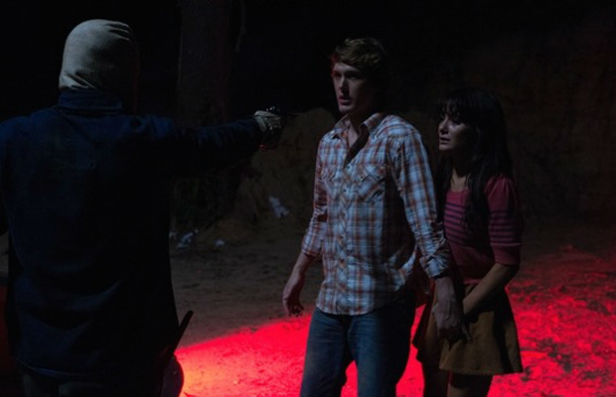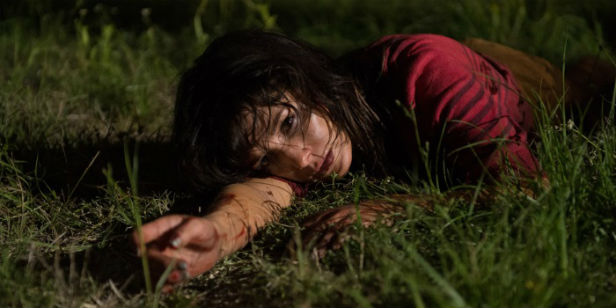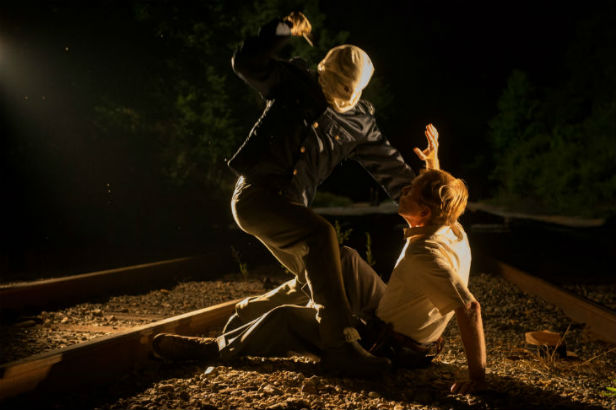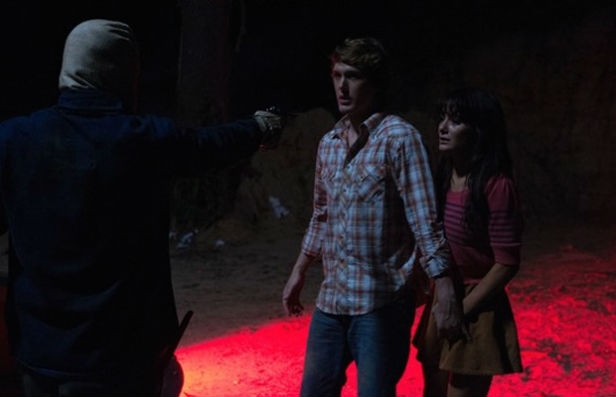 Alfonso Gomez-Rejon is riding a wave of positivity when we talk to him, as his personal drama Me And Earl And The Dying Girl has recently premiered at Sundance to a rapturous reception. That movie may not be out yet, but you know his work. He helped define the brilliantly stylish look of Ryan Murphy and Brad Falchuk’s American Horror Story, and his Murphy-produced debut, The Town That Dreaded Sundown, hits UK cinemas next week.
Alfonso Gomez-Rejon is riding a wave of positivity when we talk to him, as his personal drama Me And Earl And The Dying Girl has recently premiered at Sundance to a rapturous reception. That movie may not be out yet, but you know his work. He helped define the brilliantly stylish look of Ryan Murphy and Brad Falchuk’s American Horror Story, and his Murphy-produced debut, The Town That Dreaded Sundown, hits UK cinemas next week.
It’s a remake of the kind-of-based-on-a-true-story 1976 slasher, and finds the town of Texarkana still living with the memory and the original movie. When a copycat killer strikes, old secrets bubble to the surface, but are they dealing with a fan of the movie, or someone related to the original real-life killer?
We spoke to Gomez-Rejon about the pressures of taking on a remake, the risks of being pigeonholed, and how he managed to reinterpret a slasher classic.
Was it Ryan Murphy who approached you about The Town That Dreaded Sundown?
Yes, I was directing American Horror Story: Asylum and I was walking on the Paramount lot and I bumped into Ryan. He said “Come to my office, I have this idea that I’d like for you to direct.” He knew that I’d been trying to get some features off the ground, and they all took so much time and fell apart, and he said “I think you’ll have a really fun time with this one, it’s a slasher movie, I don’t know if you’re going to be into it…”
But I was obviously exploring horror on the show and having fun with it, and I was very honest and I didn’t know the original film but I went online and ordered a VHS. It was the only thing I could find, and dug up my old VHS player, which is probably the best way to see it! It reminded me of my childhood. And then I got it, I was hooked because I realised, “OK, I could make a movie about a town defined by a movie.” And that’s kind of an interesting idea for me to hang the slasher elements around that idea that I found so intriguing.
Did you have a lot of creative freedom?
Yes, it was absolute freedom. Robert Aguirre-Sacasa had already written a draft of the screenplay when I became involved and then it was just exploring my way in. As far as movies that I was thinking about were The Last Picture Show.
And I knew that my approach wasn’t going to be retro, like purposefully retro-looking or found-footage-y, I wanted to try and explore the stillness of that, and the formality of that style in an area that I know. I’m not from Texarkana but I’m from a different border town, and a lot of the towns around are quite quiet and almost frozen in time. And I thought “OK, I could do something here that artistically would challenge me and take me in a new direction, in addition to embracing the genre and having fun with it.” And so I was hooked at that point.
Were you worried about being pigeonholed as a horror director?
Yes. I had been doing American Horror Story and I’ve always loved horror, I never thought of myself as the horror guy. But I was enjoying it because of how expressive the filmmaking can be. And Ryan thought that I could bring something new to the film. But there was a little nervousness; it’s tricky because you don’t want to be defined by that.
Even though you’ll always be defined by your work, you don’t want to be put in a box. But I can’t obsess about whether people are going to put me in a box or not so you just kind of jump in and try to have fun with it. And I did have a movie that I was hoping to get off the ground right after that called Me And Earl And The Dying Girl, and so I knew that everything worked out fine I could have fun here and go right into this other film, and then start exploring more personal filmmaking. And it worked out.
 The film itself is quite difficult to pin down. It’s not a remake, or a sequel really…
The film itself is quite difficult to pin down. It’s not a remake, or a sequel really…
Yes, it is and that’s what I liked about it. I’m going to make a movie where I pay homage to the original film but also have that plot of the original film be the unifying structure of this one, even though we’re going to back to the original murders that inspired that film, and talking about the victims and exploring…
Even the happy accidents, when I was researching the film in Texarkana, I was at the Sheriff’s office and he happened to say in passing as a little aside that the son of Charles B Pierce, Charles B Pierce Jr lived in the town, and occasionally does work for him on his ranch. And that was such a meta accident.
So I finally got hold of him, and we met for breakfast and we continued to talk. So just to know that there was this person in the town where we’re filming the movie that was around when the original film was being made and had all these props from his dad’s films, and the way he talked about his father, I just thought that’s added another level here, we’re meant to make this movie because there’s something really interesting happening just naturally. So we wrote that character into the story.
The original is certainly well-known but it’s not on the same level as something like Halloween. Did you feel a bit more freedom to reinterpret than you might have done with a more widely-regarded original?
Regardless of what movie it was I have to respect that filmmaker and his work, so I was never out to make fun of it or deconstruct it in any kind of way. My first question to the studio, because MGM owned the rights to the original, was can I use that film in my film.
And that was key because if that hadn’t happened I don’t know that I would have made the movie, because there’s something about intercutting between the present and the way Charles B Pierce reimagined the original murders and how that film was influencing the current murders, I knew I wanted to work with that in the editing and I knew I wanted to open on the image from the film.
So I have the deepest respect for that film as I would for the original Halloween or anything like that. It was never about making fun of it in any way, that was never going to be my approach. I don’t know if that was what you’re asking…
For myself, because I’m not as familiar with the original, that the meta levels definitely added to it, the blend of the original film and the real murders.
Yeah, and in a way it’s celebrating the power of movies, how it can define a town. Because you go to Texarkana and to this day everyone talks about where they were when it was shot, they remember the camera crew here, and they were an extra, someone’s friend was an extra. And then they also know relatives who knew someone who got killed in the ’40s, or a bullet nicked them, so everyone has a version of the story that evolved with time, but it’s so current.
I’m from Laredo, Texas and I remember in the’ 70s they shot a movie there called Eddie Macon’s Run. No one in the world knows about this movie but everyone in my hometown knows about this movie because there’s something about a movie company invading a town that will never have that happen again that defines it and it’s such a clear moment in time that is never forgotten. But to have a movie that defines a town, and murders that defined it beforehand, and a movie that opened up those wounds, I just thought that was a really interesting world to set a slasher movie.
 There are some fantastic veteran actors in the film, like Gary Cole, Veronica Cartwright and the late Edward Herrmann. What was it like working with them?
There are some fantastic veteran actors in the film, like Gary Cole, Veronica Cartwright and the late Edward Herrmann. What was it like working with them?
They’re brilliant. I miss Ed Herrmann deeply. We became friends on that film and there’s nothing like going out to dinner with him on a weekend and just ask him stories about Reds and Warren Beatty. He’d been on so many movies, I really miss him. But they all…Veronica Cartwright who’s a legend and Gary Cole, who’s the very first person to sign on to make this movie because I knew he was the very first person I wanted to play that character.
And they all understood the movie which I was trying to make, which was a very still movie, which was quite serious, but also there was a sense of humour about it and a meta quality that hopefully wasn’t too flashy, it was just very subtle. And they all really liked the big idea of the film and came in and had fun with the roles and really made them real within this hyper real universe, they really found the truth to them.
Have you been surprised by the success of American Horror Story?
I’m not surprised at all, it’s such a unique show, I’ve never seen anything quite like it. And I’ve been involved since the very first episode of the very first season, I directed the second unit for Ryan’s pilot. I’ve been involved ever since then, and it seemed to by the middle of the first season have caught on in a way that I’ve never seen anything catch on. Such dark, twisted material and people were watching and talking about it.
And by the time Asylum started and how it completely reinvented the premise in the world and kept the same players, I just thought it was so innovative and so fun to be a part of it. So it was sad that Season 4 was my last but only because I’m going on to making my features, like Me And Earl And The Dying Girl that I just finished. I love the fact that I was a part of that because it really helped me express myself and hone my skills and direct a cast that’s really unparalleled.
Speaking of Me And Earl And The Dying Girl, it must have been great to get that reaction at Sundance to something that’s so personal.
Yes, there’s nothing more beautiful than that experience. Because I had to go deep and I needed to go personal, and there’s always a fear that you will only be thought of as a horror person because of the success of a television show, and because my first film was The Town That Dreaded Sundown, but it was nice to have an opportunity, because of everything that came before it, to be able to be given the opportunity to make a personal film. And the fact that people are responding to it is both so cathartic to me because of why I made it, but also it’s important to me as a filmmaker.
It also celebrates British film in a really fun way, with little homages to Powell and Pressburger and The Red Shoes and Tales Of Hoffman and of course Peeping Tom. Because they spoof movies within the movie, and Brian Eno did the music!
Finally, do you have a favourite slasher movie?
I love a lot of the early De Palma, I love Sisters, I don’t know if you’d really call that a slasher movie! Probably the weirdest one is maybe Tourist Trap from 1979, there’s a weird death scene with all the mannequins that I can’t stop thinking about sometimes. And I tried to do a sequence in The Town That Dreaded Sundown inspired by that when she’s running from the killer and she goes through an abandoned five and dime store but we ran out of time and never shot it. But it’s probably for the best because nothing can beat that. It’s so artfully directed and well composed as well which I really appreciate, like all the wonderful Argento movies that I adore.
Suspiria is probably way up there. I learn from that movie all the time because it just informs everything, cinematography, and design, the art direction in that is amazing so that’s probably number one.
The Town That Dreaded Sundown is released in UK cinemas 17 April. Keep up with the latest horror news with the new issue of SciFiNow.
